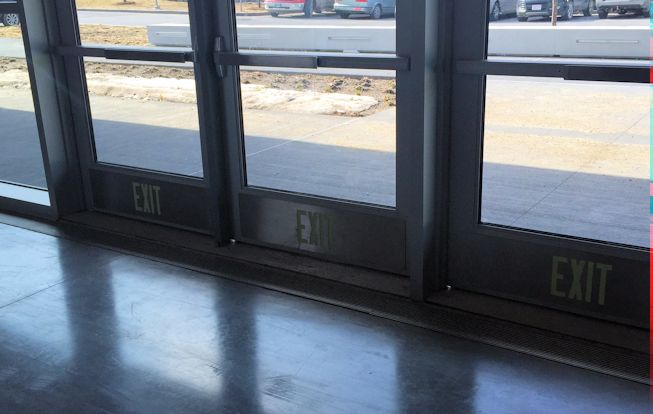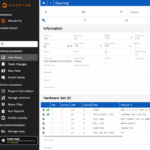To anyone who complained about the lack of a Wordless Wednesday post yesterday, it was there! I just posted the draft script afterward so it showed up on top of the WW post in the email notification. If you missed it, consider this Tight-Lipped Thursday. 🙂
John Gant of Allegion sent me a very interesting question this morning (well, it was interesting to me anyway!). This photo was taken at a new athletic center in Vermont. The kick plates have luminous “EXIT” signage on them, and John was told that this was a code requirement.
Should we be specifying and supplying kick plates with a luminous “EXIT” on them? I tried to find out.
The 2012 Vermont Fire and Building Safety Code is based on the 2012 edition of NFPA 101 – The Life Safety Code and the 2012 edition of the International Building Code (IBC), along with state modifications. I checked the Vermont modifications first and didn’t see anything that would require this signage, so this doesn’t appear to be a Vermont-specific issue.
The 2012 edition of NFPA 101 does include a section (7.2.2.5.5.8) requiring emergency exit symbols applied within the bottom 18 inches of the door, but this is part of section 7.2.2.5.5 Exit Stair Path Markings. Doors are only required to comply with this section when they are part of the means of egress out of an exit enclosure, and only when required by the occupancy chapters. In the 2012 edition, I don’t see any references in the occupancy chapters that would require these markings, and if they were required, there are additional markings that would be required – like the stripe around the frame and the markings on the operable hardware (there’s an article about luminous egress path markings here).
The 2012 IBC (section 1024) requires luminous egress path markings (including an EXIT symbol in the bottom 18 inches of the door) in high-rise buildings in Group A, B, E, I, M, and R-1, but this only applies to interior exit stairways, interior exit ramps and exit passageways, and again – other markings would be required – not just the EXIT symbol.
Then I thought maybe it had something to do with the requirements for floor proximity exit signage – I’ve seen these EXIT kick plates on some hotels lately.
The 2012 IBC (1011.2) requires low-level exit signs where exit signs are required in areas serving guest rooms in Group R-1 occupancies, which covers hotels, motels, boarding houses (>10 occupants), and congregate living facilities (>10 occupants), so that requirement would not apply to the athletic facility. Do keep it in mind for your R-1 projects though.
I checked the 2012 edition of NFPA 101, and found this paragraph:
7.10.1.6* Floor Proximity Exit Signs. Where floor proximity exit signs are required in Chapters 11 through 43, such signs shall comply with 7.10.3, 7.10.4, 7.10.5, and 7.10.6 for externally illuminated signs and 7.10.7 for internally illuminated signs. Such signs shall be located near the floor level in addition to those signs required for doors or corridors. The bottom of the sign shall be not less than 6 in. (150 mm), but not more than 18 in. (455 mm), above the floor. For exit doors, the sign shall be mounted on the door or adjacent to the door, with the nearest edge of the sign within 4 in. (100 mm) of the door frame.
This paragraph does not apply unless an occupancy chapter references it, and the only references I found were in the Assembly occupancy chapters, and only required for special amusement buildings – like haunted houses and laser tag facilities (12.4.7.7.2/13.4.7.7.2) – not all Assembly occupancies. John sent me the photo below of another bank of doors serving this space. The illuminated exit sign was installed beside these doors, but wouldn’t work well for the aluminum storefront doors.
So our question remains…Is there a code requirement for kick plates marked “EXIT” on an athletic facility? Enquiring minds want to know.
You need to login or register to bookmark/favorite this content.








Not sure about the Exit Signs but I would question their paint job on the doors, seems to blend in too much with the surrounding walls unless it’s a nursing care facility but we know it’s not.
I’m interested in the correct answer.
You’re right – the doors do blend in quite a bit. Apparently the AHJ didn’t have a problem with them.
Maybe it’s for the people who are constantly on their smart phones. That way they don’t have to tilt their head up to find the exit!
I would suggest no, not required to be on a kickplate due to the last sentence containing: “…or adjacent to the door…”. It also indicates where to locate the sign if not door-mounted. Based on how it is written, I would say either method meets the requirement as far as NFPA 101 goes. This is ripe for some manner of TIA question interpretation. To add to the (potential) confusion, what does 2012 IFC reference?
Also, in the second photo, what are the motion sensors releasing? Otherwise, it seems like a fairly straightforward application….
The sensors are probably for the detection system – to signal a legal release.
I don’t know whether there’s a Code which requires EXIT signs on doors, but I think it’s a great idea for some applications. Years ago, in my first “real” job out of college, the architect who was my boss said he didn’t understand why EXIT signs were required to be posted over doors where the smoke would obscure them in a fire. He said, “They should be six inches above the floor, where someone crawling below the smoke can see them.” Obviously, in an Assembly use, EXIT signs placed high are needed so people can see them from across the room, and over the heads of the other people. But low ones make sense, too. I have seen them in hotels and I, for one, am glad to see that requirement being adopted.
Lori, the exit sign placement is for athletic building where the home team always loses. It is so their fans can leave with their heads down and know how to get out.
Love this reasoning!
My guess it is just some spec writer’s or architect’s “good idea”. Often the best way to keep something in the spec (if it is required or not) is to say it is “because of code”. Most people won’t check.
I, for one, think it works and looks good.
I guess I am not “most people.” 🙂
Most people reading this blog are not “most people”. We are the 2% who will check. 😉
“It’s in the code” is similar to one of my favorite phrases that is sometimes used by AHJ’s: “because I said so”.
Most of the questions I get are from AHJ’s (generally California local fire marshals) who start their question with: “I need to cite a code for this situation. I’m using the ‘because I said so’ code for now”.
Lots of things are done on projects without specific code attribution, but when someone will infer the authority of a code.
I’m not sure how well a low mounted sign would be visible through a throng of people exiting unless anti-gravity took over and people floated out the doors…I guess at the point where it becomes a throng one could just take the Lemming approach, “I’ll follow the crowd they must know which way to go.” Not my style, I prefer to know rather than guess.
Lori, I may have some responsibility for this. I worked Security at UVMMC before it was so closely tied to UVM. I was on the safety comm. As Joanne G points out I thought that the exit signs in the halls would be obscured in a fire. I was able to talk the safety comm. into trying out several types of signs on the lower portion of the exit stair doors. This was very well received and a decision was made to put them on all such doors. Since I left employment the Hospital and University have become much closely affiliated. It may be that the idea was transferred to the new facility in this way.
Thanks George. I was just wondering if there was a particular code requirement driving the location of the signage. I want to make sure I don’t miss anything. 🙂
– Lori